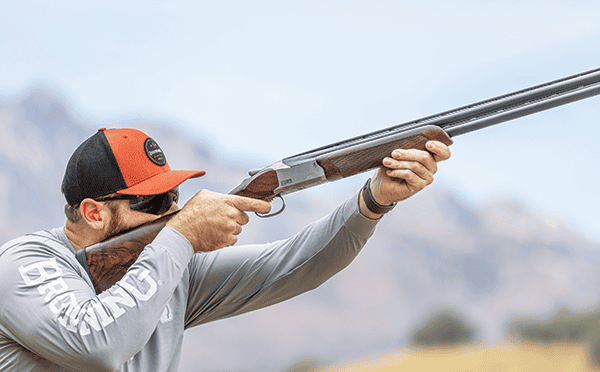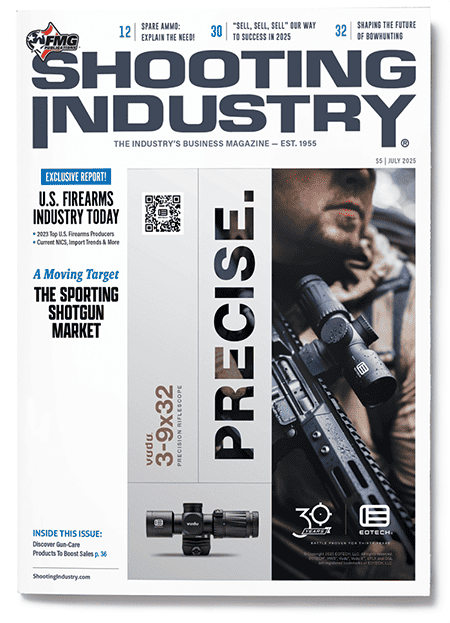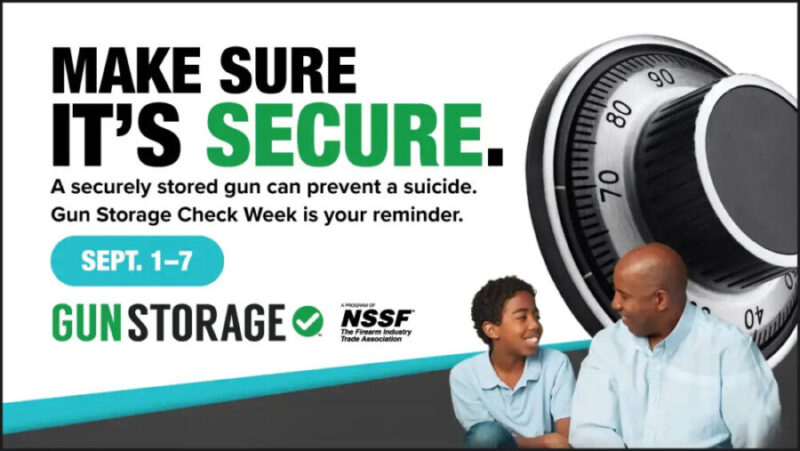Shotgun Market: A Moving Target
Clay target shotgun sports offer year-round income to retailers as part of a larger marketing model.
Many variables influence the potential in the target segment of a retailer’s business model. A local shooting club, for example, is an endemic source of customers who buy targets, ammunition, shotguns and accessories.
Some states underwrite youth shooting sports programs operated cooperatively through schools, wildlife management agencies and 4-H. In 2025, the Arkansas Youth Shooting Sports program, administered by the Arkansas Game and Fish Commission, supported 5,725 youths representing 333 schools.
Jose Jimenez, chief of the Arkansas Game and Fish Commission’s education division, said the program is directly responsible for $500,000 in sales. The program spends $200,000 annually to provide ammunition, eye protection and ear protection for youth participants. An individual school allocation supplies enough ammunition for as many as five practice sessions. Coaches and parents buy additional ammo to facilitate more practice sessions.
“I’d say most coaches are trying to match what we provide them so they can do more practices than what we require,” Jimenez shared. “They’re paying more for ammunition straight off the shelf. We buy in bulk and have tax exemptions. The compilation of coaches buying ammo independently matches us or higher.”
Newcomers often start with well-worn field guns and upgrade to elite-brand over/unders. These stories are not urban legends. Kayle Browning, an alumna of the Arkansas Youth Shooting Sports Program, won a silver medal for trap at the 2020 Olympic Games. Alumni of 4-H shooting sports programs in Texas, Georgia and other states have competed at the Olympic level, as well.
States like Ohio have high participation in American Trap Shooting Association events. Add skeet shooting, 5-stand and sporting clays participation to the mix, and the potential for shotgun-related sales is apparent.
An “Active” Market
Tom Denniston, owner of Fort Thompson Sporting Goods in Sherwood, Ark., is perfectly positioned to support shotgun sports in central Arkansas.
A few miles north in Jacksonville is a modern shooting facility owned by the Arkansas Game and Fish Foundation. It is the hub of the state’s youth shooting sports culture and site of the annual state championships. It also hosts an endless array of adult trap benefit shoots.
A few miles east at Remington’s sporting ammunition plant in Lonoke is the Remington Gun Club. Its well-manicured trap and skeet fields and its modern sporting clays range host many benefit shoots.
Two miles south, near Little Rock National Airport, is Blue Rock Gun Club, a private facility that hosts many sanctioned trap and skeet shoots. Denniston sells a lot of product to all of these shotgun communities, but his customers are not all local.
“We mostly sell our ammo to the young people,” he said. “The biggest thing for us in the past 10 years is selling target loads. It’s big-time. We have people come from all over the state. Corning [High School] buys a ton of stuff from us, and it’s a good two hours away. We sell a lot in Northwest Arkansas, too.”
Denniston said this portion of his business is based entirely on volume.
“I make $8 per case of shells,” he noted. “That ain’t much, is it? But it’s worth it to us because it builds good relationships. They can’t buy it from Walmart as cheaply as they get it from me. I try to promote our name.”
Denniston also promotes Fort Thompson’s name by sponsoring a youth shooting event. He said he provides about $1,500 worth of merchandise to participants. The main advantage of supporting target shooting is that it’s an active market when hunting seasons are closed.
“Summertime is just dead,” he added.
TriStar is very popular with teenage shotgunners, Denniston informed. Browning, Beretta, Franchi and SKB are also popular. Avid competitive shooters usually buy high-end target shotguns directly from representatives at ATA shoots, but it is a small universe, Denniston reasoned. When a customer comes to Fort Thompson for such a gun, he said it is essential to have it or be able to get it promptly.
“Our basic Beretta trap gun is a little over $4,000, but you can buy a TriStar for $1,200, and there’s nothing wrong with it,” Denniston stated. “They’re good guns. The Beretta gun we have right now is $6,200. We probably sell two or three max. For sporting clays, we mostly sell automatics.”
Target Treasure Chest
When you enter the parking lot at Gene Sears Supply in El Reno, Okla., the prefabricated metal building looks like a place that sells HVAC equipment. When you go inside, however, it’s like entering King Tut’s Tomb (if Tut had been a shotgunner). It’s not surprising because the late Gene Sears was a renowned trap and skeet shooter, and the business is tailored to an avid target-shooting clientele.
“We’ve got lower-end guns, but we also have a Purdey side-by-side sitting here,” said Garland Sears, owner and general manager. “We have several Krieghoffs and a few Perazzis.”
Local schools support successful youth shooting sports programs, but Sears says his biggest liability is being too far from Oklahoma City. Because of its location and its reputation, Gene Sears’s clientele is highly specialized, but it is also very loyal. Their preferences span all economic strata.
Unlike Fort Thompson, Gene Sears has Krieghoff, Perazzi and Kolar on site. Sears contends being able to handle these guns makes his business unique.
“We’re the only retail shop where folks can come in and handle guns,” he said. “Most shops, all the guns are behind the counter. It’s the way we’ve always done it, and it seems like it works for us.”
Sears said Stoeger is the ubiquitous brand in Oklahoma’s youth shooting sports program tournaments, but he sells a range of brands to youth tournament participants.
“We sell a few TriStars, but I’m not a dealer for them,” he stated. “We sell a lot of Brownings and Beretta automatics, especially A300s. Those are really good guns. We sell quite a few Franchis, too, and Benelli Ethos and Montefeltro. We sell a lot of Stoegers. They don’t cost much, but seem to be really a good gun.”
Sears, also an accomplished clay shooter, said it is important to make it easy for a shooter to buy the gun they need.
“We try to get them fitted with a gun,” he explained. “If have problems with it, if they bring the gun back in the same condition, we basically give them the same thing back they paid to trade in for something else. If they feel a gun doesn’t fit right, we’ll get them in a gun they can shoot.”
Avid Shooters
Sportsman’s Den in Shelby, Ohio, is near the Cardinal Shooting Center in Marengo, which has 100 trap fields that host 3,500 participants annually for the Scholastic Clay Target Program. It also hosts the Ohio State Shoot and two other ATA registered shoots.
“We sell a semi (trailer) load of shells in one week,” said Greg Griffith, owner of the Sportsman’s Den.
That’s a lot of shells obviously, but as Tom Denniston mentioned, it doesn’t generate huge profits It does, however, give Sportsman’s Den a prominent presence at highly prominent events among an avid clientele.
“The thing about clay shooting is you have to be willing to work on a little shorter margin,” Griffith stated. “Trap shooters will drive 100 miles to save a dollar on a case of shells. I make $7 or $8 a case on shells, but we sell a lot. Sometimes it gets discouraging, but I’ve got to move product.”
The Sportsman’s Den’s custom-wrapped trailer is a fixture at the Scholastic Clay Target Program. Because it provides such prominent exposure, Griffith said there’s no need to do something as labor-intensive as hosting or sponsoring an independent shoot.
“The trailer has a 53′ deck,” Griffith said. “We’ve been around 40 years this year. At the kids’ shoot, we’re the only ones selling ammo. They shoot a million rounds. We’re really not promoting youth shooting enough in Ohio, Minnesota and Wisconsin, but all those schools have teams.”
“I Don’t Know If You Can Wear One Out.”
According to Griffith, custom gun sellers are present at all of the major shoots. They dominate that market.
“Our store is 52,000 sq. ft., but there’s not a lot of consumers buying that level of gun,” Griffith observed. “They don’t sell fast. And a lot of the guys shooting those brands bought them in the ’80s. That’s why you spend that kind money — when you’re shooting them 10,000 to 20,000 times a year.”
On the other hand, Griffith said there is a consistent demand for more conventional target models.
“It’s across the board,” he remarked. “We sell quite a few TriStars. We sell some Berettas. Winchester and SKB have a good following. The old BT-99 Browning costs about $1,500, and there are tons of them out there. There’s one with an adjustable rib made exclusively for us. We sell quite a few of those. You can shoot a billion rounds. I don’t know if you can wear one out.”
Although sub-gauges are increasingly popular in hunting, 12-gauge is still the standard for shooting clay targets, even among youths.
“A 12-gauge target load is only 7/8 of an ounce,” Griffith pointed out. “It’s a really light load.”
Buy Early, Stay Engaged
All of our sources say the objective for servicing the clay target community is continuous engagement and brand promotion. The customer who comes to you to buy a shotgun, ammo and accessories for their youth shooting sports participant will probably come to you for their other shooting needs later.
“Don’t expect to get rich in the target business,” Griffith counseled. “You’ve got to buy everything in volume. If you run out of shells, you can’t call the factory and say, ‘Send me a skid tomorrow.’ It might take two months. If you don’t stock up early, you don’t get them. You don’t want to work on borrowed money in the target business, where your money is tied up for six months before you sell it. A lot of big stores stay out of it for that reason.”
Even with margins increasingly lean these days, there’s something to be said about staying active in your community to help grow the sport.






